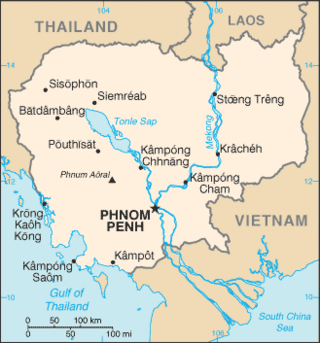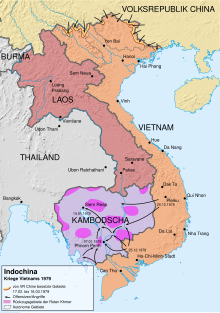
The People's Army of Vietnam (PAVN), officially the Vietnam People's Army, also recognized as the Vietnamese Army or the People's Army, is the national military force of the Socialist Republic of Vietnam and the armed wing of the ruling Communist Party of Vietnam (CPV). The PAVN is a part of the Vietnam People's Armed Forces and includes: Ground Force, Navy, Air Force, Border Guard and Coast Guard. Vietnam does not have a separate Ground Force or Army service. All ground troops, army corps, military districts and special forces belong to the Ministry of National Defence, directly under the command of the CPV Central Military Commission, the Minister of National Defence, and the General Staff of the Vietnam People's Army. The military flag of the PAVN is the National flag of the Socialist Republic of Vietnam defaced with the motto Quyết thắng added in yellow at the top left.

The Kingdom of Cambodia, also known as the First Kingdom of Cambodia, and commonly referred to as the Sangkum period, refers to Norodom Sihanouk's first administration of Cambodia from 1953 to 1970, an especially significant time in the country's history. Sihanouk continues to be one of the most controversial figures in Southeast Asia's turbulent and often tragic postwar history. From 1955 until 1970, Sihanouk's Sangkum was the sole legal party in Cambodia.

The Cambodian Civil War was a civil war in Cambodia fought between the forces of the Communist Party of Kampuchea against the government forces of the Kingdom of Cambodia and, after October 1970, the Khmer Republic, which had succeeded the kingdom.

Kriangsak Chamanan served as prime minister of Thailand from 1977 to 1980. After staging a successful coup, he was asked to become Prime Minister in 1977. He ruled till 1980 and is credited with "steering Thailand to democracy" in a time where communist insurgents were rampant internally and neighbouring countries turned to communist rule following the communist takeover of Vietnam: South Vietnam, Laos, and Cambodia.

The Sino-Vietnamese War was a brief conflict that occurred in early 1979 between China and Vietnam. China launched an offensive ostensibly in response to Vietnam's invasion and occupation of Cambodia in 1978, which ended the rule of the Chinese-backed Khmer Rouge. The conflict lasted for about a month, with China withdrawing its troops in March 1979.
During the Cold War, the Indochina Wars were a series of wars which were waged in Indochina from 1946 to 1991, by communist forces against the opponents. The term "Indochina" referred to former French Indochina, which included the current states of Vietnam, Laos, and Cambodia. In current usage, it applies largely to a geographic region, rather than to a political area. The wars included:

The Cambodian–Vietnamese War was an armed conflict between Democratic Kampuchea, controlled by Pol Pot's Khmer Rouge, and the Socialist Republic of Vietnam. The war began with repeated attacks by the Liberation Army of Kampuchea on the southwestern border of Vietnam, particularly the Ba Chúc massacre which resulted in the deaths of over 3,000 Vietnamese civilians. On 23 December 1978, 10 out of 19 divisions of Khmer Rouge's military divisions opened fire along the shared Southwestern borderline with Vietnam with the goal of invading the Vietnamese provinces of Đồng Tháp, An Giang and Kiên Giang. On 25 December 1978, Vietnam launched a full-scale invasion of Kampuchea, and subsequently occupied the country in 2 weeks and removed the government of the Communist Party of Kampuchea from power. In doing so, Vietnam put an ultimate stop to the Cambodian Genocide, which had most likely killed between 1.2 million and 2.8 million people — or between 13 and 30 percent of the country’s population.

Army and warfare made their first appearance in Vietnamese history during the 3rd millennium BC. Throughout thousands of years, wars played a great role in shaping the identity and culture of people inhabited the land which is modern day Vietnam. Vietnam is regarded as one of the most militaristic countries in Southeast Asia, there is even a higher level belief Vietnam might be the most militaristic nation in Southeast Asia, and one of Asia and the world's most militaristic countries. The military history of today’s Socialist Republic of Vietnam began when Japan invaded French Indochina, they defeated the French resistance after nearly a hundred years of oppression and inspired many countries worldwide to take up the fight against foreign invaders. Since then, Vietnam has fought in many conflicts.

The Khmer National Armed Forces were the official armed defense forces of the Khmer Republic, a short-lived state that existed from 1970 to 1975, known today as Cambodia. The FANK was the successor of the Royal Khmer Armed Forces (FARK) which had been responsible for the defense of the previous Kingdom of Cambodia since its independence in 1953 from France.
The insurgency in Laos is a low-intensity conflict between the Laotian government on one side and former members of the Secret Army, Laotian royalists, and rebels from the Hmong and lowland Lao ethnic minorities on the other. These groups have faced reprisals from the Lao People's Army and Vietnam People's Army for their support of the United States-led, anti-communist military campaigns in Laos during the Laotian Civil War, which the insurgency is an extension of itself. The North Vietnamese invaded Laos in 1958 and supported the communist Pathet Lao. The Vietnamese communists continued to support the Pathet Lao after the end of the Laotian Civil War and the establishment of the Lao People's Democratic Republic. At least 100,000 Hmong civilians were killed as the result of Laotian governmental policies, in what has sometimes been referred to as the Hmong genocide.
The International Agreement on the Neutrality of Laos is an international agreement signed in Geneva on July 23, 1962 between 14 states, including Laos, as a result of the International Conference on the Settlement of the Laotian Question, which lasted from May 16, 1961 to July 23, 1962.

The Sihanouk Trail was a logistical supply system in Cambodia used by the People's Army of Vietnam (PAVN) and its Viet Cong (VC) guerillas during the Vietnam War (1960–1975). Between 1966 and 1970, this system operated in the same manner and served the same purposes as the much better known Ho Chi Minh trail which ran through the southeastern portion of the Kingdom of Laos. The name is of American derivation, since the North Vietnamese considered the system integral to the supply route mentioned above. U.S. attempts to interdict this system began in 1969.
Operation Freedom Deal was a military campaign led by the United States Seventh Air Force, taking place in Cambodia between 19 May 1970 and 15 August 1973. Part of the larger Vietnam War and the Cambodian Civil War, the goal of the operation was to provide air support and interdiction in the region. Launched by President Richard Nixon as a follow-up to the earlier ground invasion during the Cambodian Campaign, the initial targets of the operation were the base areas and border sanctuaries of the People's Army of Vietnam (PAVN) and the Viet Cong (VC).

The People's Republic of Kampuchea (PRK) was a partially recognised state in Southeast Asia which existed from 1979 to 1989. It was a client state of Vietnam, founded in Cambodia by the Vietnamese-backed Kampuchean United Front for National Salvation, a group of Cambodian communists who were dissatisfied with the Khmer Rouge due to its oppressive rule and defected from it after the overthrow of Democratic Kampuchea, Pol Pot's government. Brought about by an invasion from Vietnam, which routed the Khmer Rouge armies, it had Vietnam and the Soviet Union as its main allies.
After the 1978 Vietnamese invasion of Cambodia and subsequent collapse of Democratic Kampuchea in 1979, the Khmer Rouge fled to the border regions of Thailand, and, with assistance from China, Pol Pot's troops managed to regroup and reorganize in forested and mountainous zones on the Thai-Cambodian border. During the 1980s and early 1990s Khmer Rouge forces operated from inside refugee camps in Thailand, in an attempt to de-stabilize the pro-Hanoi People's Republic of Kampuchea's government, which Thailand refused to recognise. Thailand and Vietnam faced off across the Thai-Cambodian border with frequent Vietnamese incursions and shellings into Thai territory throughout the 1980s in pursuit of Cambodian guerrillas who kept attacking Vietnamese occupation forces.
The earliest traces of armed conflict in the territory that constitutes modern Cambodia date to the Iron Age settlement of Phum Snay in north-western Cambodia.

The Sino-Vietnamese conflicts of 1979–1991 were a series of border and naval clashes between the People's Republic of China and the Socialist Republic of Vietnam following the Sino-Vietnamese War in 1979. These clashes lasted from the end of the Sino-Vietnamese War until the normalization of ties in 1991.

Khmer nationalism is a form of nationalism found in Cambodia, that asserts that Khmers (Cambodians) are a nation and promotes the cultural unity of the Khmer (Cambodian) race.
The United Front for the Liberation of Oppressed Races waged a nearly three decade long insurgency against the governments of North and South Vietnam, and later the unified Socialist Republic of Vietnam. The FULRO insurgents represented the interests of indigenous Muslim and Hindu Cham, Montagnards, and Buddhist Khmer Krom against the ethnic Kinh Vietnamese. They were supported and equipped by China and Cambodia according to those countries' interests in the Indochina Wars.
Vietnamese irredentism, also known as Ideology of Greater Vietnam, sometimes may be referred to as Baiyue Nationalism is an irredentist and nationalist claim concerning redemption of former territories of Vietnam and territories outside Vietnam that the Vietnamese have inhabited for centuries. Notable claims are usually made concerning territories of Laos, Cambodia, and Liangguang of China.













